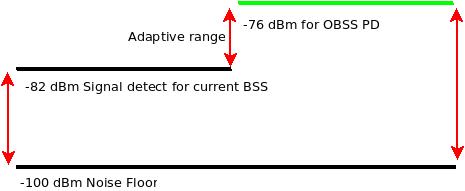For the interested reader – refer Spatial Reuse Operation and Spatial Reuse Groups for a brief on the idea of spatial reuse and what a spatial group consists of.
As we discussed in the earlier articles, It is possible to configure a different Carrier Sense Threshold for Overlapping BSS such that the Signal detect threshold for overlapping BSS is higher and the signal detect for current associated BSS is lower.
If the overlapping BSS threshold is higher, the current non-AP station can determine to still transmit (albeit with certain transmit power constraints) its own packet even if a signal from the overlapping BSS is detected but is lesser than the packet detect threshold configured for that OBSS.
The above mechanism helps in the simultaneous use of the air medium by the current Station and another OBSS station. The idea of transmit power constraints is to make sure that the non-AP station does not interfere with the ongoing transmission for OBSS station.
The BSSes that are part of a Spatial Reuse Group are provided to the non-AP Station by the Access Point in the Spatial Reuse Parameter element via the “SRG BSS Color bitmap” field.
The same OBSS Packet Detect threshold is maintained for all BSSes in the Spatial Reuse group.
The below diagram illustrates the generalized OBSS PD operation:

As shown in the above diagram, the threshold for intra-BSS packets is set to a lower value than for OBSS packets. A station following OBSS PD can choose to not update its Basic NAV timer if the OBSS packet power is lesser than -76 dBm.
Both SRG and non-SRG OBSS PD mechanisms follow the same as depicted above.
Pingback: Identifying packet as SRG or non-SRG PPDU | Hitch Hiker's Guide to Learning